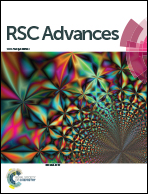Hydrothermal deposition of a zinc oxide nanorod array on a carbon nanotube film as a piezoelectric generator
Abstract
Piezoelectric generators based on zinc oxide (ZnO) nanowires/nanorods require not only an aligned assembly morphology but also Schottky contacts between ZnO and electrodes to rectify the piezoelectric signals. Here we demonstrate that two-dimensional carbon nanotube (CNT) assembly films can serve as highly efficient electrode materials to meet these two requirements. The flexibility, porosity and pore size distribution, and intimate contact with ZnO of CNT films have advantages in controllable hydrothermal deposition to generate highly aligned ZnO nanorods with high crystallinity at a high density. Due to the Schottky characteristics between ZnO and CNT, aluminum and titanium are suggested to serve as the negative electrode of a piezoelectric energy supply, by using their ohmic contacts with ZnO. The three-layered piezoelectric generator outputs a signal of 50–60 mV by using bending deformations, one order of magnitude larger than the signal generated by fast pressing deformations. This study presents a method to design ZnO-based piezoelectric generators without using precious metals or rare earth elements.


 Please wait while we load your content...
Please wait while we load your content...